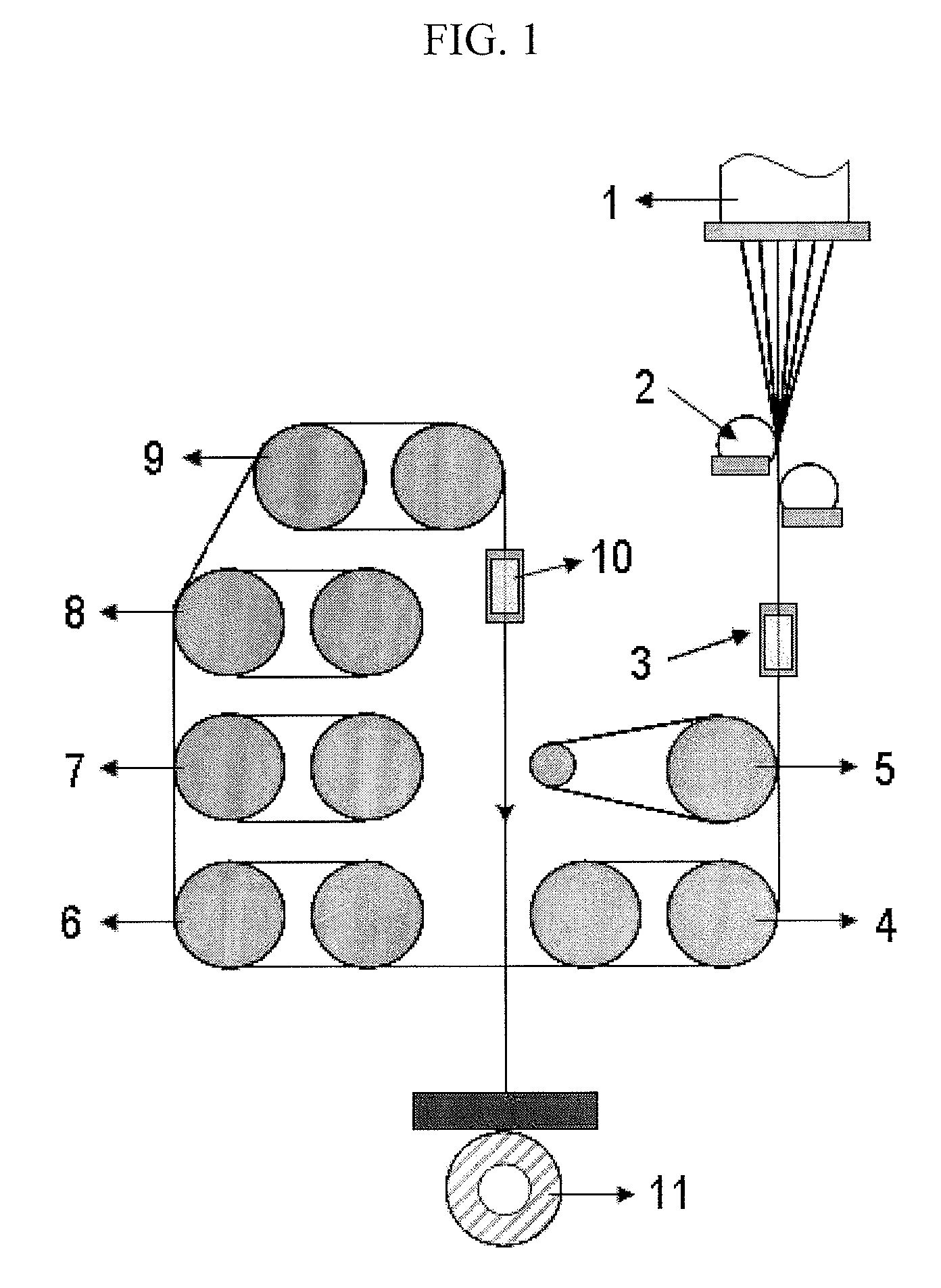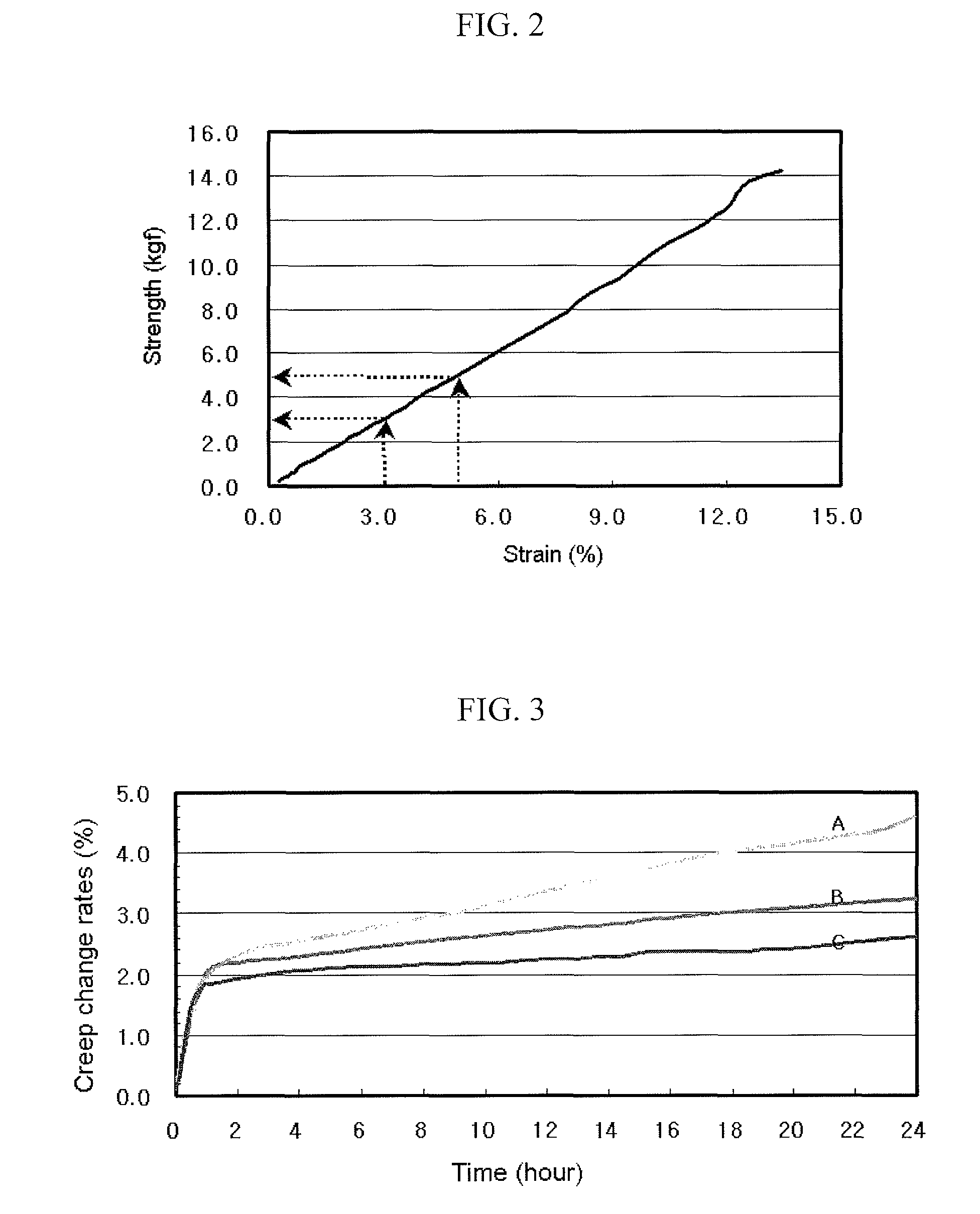Industrial high tenacity polyester fiber with superior creep properties and the manufacture thereof
a high-tenacity, polyester fiber technology, applied in the direction of yarn, transportation and packaging, synthetic resin layered products, etc., can solve the problems of affecting the application of the fiber to a real manufacturing process, large difference in intrinsic viscosity between the surface and the core, and deterioration of the processibility of the fiber, so as to achieve superior tenacity and shape stability, and reduce thermal degradation and hydrolysis. , the effect of high tenacity
- Summary
- Abstract
- Description
- Claims
- Application Information
AI Technical Summary
Benefits of technology
Problems solved by technology
Method used
Image
Examples
experimental example 1
[0047](Measurement of Intrinsic Viscosity and Creep Change Rate)
[0048]Intrinsic viscosity and creep change rate of Examples 1-5 and Comparative Examples 1-2 were measured, and the results are listed in Table 2.
[0049]The intrinsic viscosity and creep change rate in Table 2 were measured according to the following methods.
[0050](1) Intrinsic Viscosity (IV): after extracting spinning oil from a specimen with carbon tetrachloride and dissolving the specimen in orthochlorophenol (OCP) at 160±2° C., the viscosity of the specimen in a capillary was measured by using an automatic viscometer (Skyvis-4000) at a temperature of 25° C. and the intrinsic viscosity (IV) of the fiber was calculated according to the following Calculation Formulae.
Intrinsic Viscosity (IV)={(0.0242×Rel)+0.2634}×F [Calculation Formula 1]
Rel=(seconds of solution×specific gravity of solution×viscosity coefficient) / (OCP viscosity) [Calculation Formula 2]
F=(IV of the standard chip) / (average value of three IV measured f...
experimental example 2
[0059](Measurements of Tensile Tenacity and Breaking Strain)
[0060]Tensile tenacity and breaking strain were measured with regard to Examples 1-5 and Comparative Examples 1-2, and the results are listed in Table 3. The tensile tenacity and the breaking strain represent values converted (ASTM D 885) from values of strength and displacement measured by using a universal testing machine (INSTRON).
Tenacity (g / d)=Strength (g) / Fineness of the fiber (De) [Calculation Formula 5]
Fineness of mono-filament (De′)=Total fineness of the fiber / Number of the filaments [Calculation Formula 6]
[0061]Furthermore, the dry heat shrinkage rate is a value measured after leaving the fiber at 150° C. for 30 minutes. That is, the dry heat shrinkage rate is obtained by the method of selecting 40 fibers and measuring the length (L1) thereof while giving an initial load of ⅓ g / d, and then measuring the length (L2) after treating the fibers in an oven at 155° C. for 30 minutes.
Dry heat shrinkage rate (%)=(L1-L...
PUM
| Property | Measurement | Unit |
|---|---|---|
| dry heat shrinkage rate | aaaaa | aaaaa |
| temperature | aaaaa | aaaaa |
| temperature | aaaaa | aaaaa |
Abstract
Description
Claims
Application Information
 Login to View More
Login to View More - R&D
- Intellectual Property
- Life Sciences
- Materials
- Tech Scout
- Unparalleled Data Quality
- Higher Quality Content
- 60% Fewer Hallucinations
Browse by: Latest US Patents, China's latest patents, Technical Efficacy Thesaurus, Application Domain, Technology Topic, Popular Technical Reports.
© 2025 PatSnap. All rights reserved.Legal|Privacy policy|Modern Slavery Act Transparency Statement|Sitemap|About US| Contact US: help@patsnap.com



